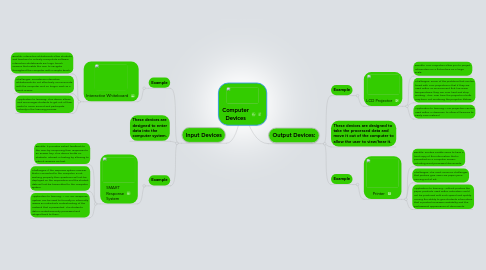
1. Input Devices
1.1. Example
1.1.1. Interactive Whiteboard
1.1.1.1. Benifits: Interactive whiteboards allow students and teachers to actively manipulate software. Interactive whiteboards are huge tourch screens that inable the user to navigate throughout the computer with a simple touch.
1.1.1.2. Challanges: Sometimes interactive whiteboards do not effectively communicate with the computer and no longer work as a touch screen.
1.1.1.3. Application to learning: This device allows and encourages students to get out of their seats to move around and participate actively in the learning process.
1.2. These devices are designed to enter data into the computer system.
1.3. Example
1.3.1. SMART Response System
1.3.1.1. Benifits: It provides instant feedback to the user, by comparing their responses to an answer key. This device builds on students' interest in texting by allowing to submit answers via text.
1.3.1.2. Challanges: If the response system receiver that is connected to the computer is not working properly then questions will not be displayed on the responders and the student data will not be transmitted to the computer system.
1.3.1.3. Application to learning: A SMART Response System can be used to formally or informally assess an individuals understanding of the material that is presented. The student's data is instantaneously processed and relayed back to them.
2. Output Devices:
2.1. Example
2.1.1. LCD Projector
2.1.1.1. Benifits: LCD Projectors allow you to project information on a flat surface on a large scale.
2.1.1.2. Challenges: Some of the problems that can be faced with LCD projectors is that if they are used within an environment that has warm temperatures, they can over heat and stop working. Also, over time the projector's bulb may burn out rendering the projector lifeless.
2.1.1.3. Application to learning: LCD projectors can be used within a classroom to allow all learners to easily view material.
2.2. These devices are designed to take the processed data and move it out of the computer to allow the user to view/hear it.
2.3. Example
2.3.1. Printer
2.3.1.1. Benifits: Printers enable users to have a hard copy of the information that is presented on a computer screen, including word processed documents.
2.3.1.2. Challenges: The most common challenges that printers give users are paper jams, running out of ink.
2.3.1.3. Application to learning: Without printers the paper products used within education could not be produced with such speed and quality. Having the ability to give students information that is printed increases readability and the professional apprearance of documents.
